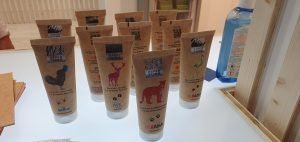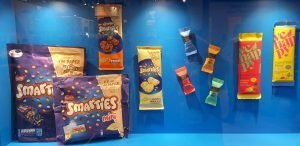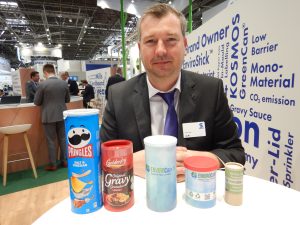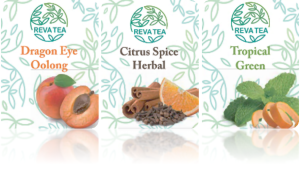It’s no surprise in the context of rising energy costs, environmental worries, and sustainability concerns – pulp and paper-based packaging are being hyped. Numerous actors are looking at substituting polymer packs with natural fiber-based solutions. The technical challenges remain but new solutions emerge daily. Dominique Huret from Cape Decision reports on some of these developments at the recent Interpack in Dusseldorf for Packaging South Asia.

The plastic coating that is traditionally required for the protection and heat-sealing of most paper packaging makes it difficult to recycle. Hence, UPM Specialty Papers and Henkel have reworked the concept. Based on existing UPM Asendo and UPM Asendo Pro barrier papers, the water-based coatings LOCTITE LIOFOL HS 2809-22 RE heat seal and AQUENCE EPIX BC 6134 grease barrier are added. These recyclable barrier papers are made from fiber sourced from what the company describes as ‘sustainably managed forests.’
The resulting pouches are easy to recycle and contribute to the recovery of more fibers and this meets growing consumer and regulatory demands for easy-to-recycle packaging. “Barrier and heat seal coatings behave differently on different paper substrates. It can therefore be difficult to find the best combination of paper substrate, coatings, and optimum application. We have refined our heat seal and greaseproof coatings through many trials and a lengthy development process. Together with UPM, we have developed innovative coating products that enable paper to achieve unrivaled levels of barrier performance,” said Christin Noack Market Strategy manager of Paper Solutions at Henkel.
“This solution demonstrates what can be achieved with co-created fiber-based materials. Packaging converters can choose a combination of paper and coating that has already been tested and approved, allowing them to quickly find the right solutions for their end use, without having to go through trial and error. For brand owners, this is another co-created product to support the transition from fossil-based materials to renewable and recyclable packaging,” says Mika Uusikartano, senior manager of Product Portfolio Management at UPM Specialty Papers.
Sappi and Sirane’s Earthfilm
Sappi Group showcased coated papers for a flexible packaging solution developed with Sirane’s expertise. A leader in packaging development and the largest pouch manufacturer in the UK, Sirane brought its Earthfilm which is imbued with its knowledge of packaging and coatings. Earthfilm can be supplied as flow-wrap film or pre-formed stand-up pouches, to the Sappi stand. Together the two companies also showcased their heat sealable stand-up pouch with barrier and reinforced gusset in the paper-based flexible packaging segment.

As proof of their commitment to this new segment, Sappi has recently invested multi-million Euros in a brand-new type of barrier coating line at its Alfeld mill in Germany. The state-of-the-art solution will be used to produce innovative high-barrier papers.
PulPac’s dry molded fiber rigid packaging
Claiming to be the inventor of the Dry Molded Fiber, PulPac is a Swedish packaging company whose process turns cellulose pulp into rigid, three-dimensional packaging. It is called Dry Molded Fiber since very little water is used in comparison with conventional wet molding. Owners of the company are Stora Enso, Amcor, and Aliaxis. On their Interpack stand was a whole range of molded products, from bottles to containers, cutlery, and small cans.

Interestingly, PulPac is offering a limited series of ready-to-use production lines with fast-track delivery in six months. In a recent multi-shift production run for one of its licensees, PulPac achieved 85% efficiency with its first-generation Modula pilot line at its technology center in Sweden. At its North American partner, Chicago-based Seismic Solutions, live equipment facilitates demonstrations and aims to strengthen PulPac sales and its licensed Dry Molding Fiber technology. Their stand at Interpack was packed throughout the 5-day show.
Hoffman Neopac’s paper tubes
Hoffman Neopac’s paper tubes also caught the spotlight. The Swiss packaging manufacturer demonstrated that paper tubes are a robust packaging solution. PaperX is a fiber-based laminate that uses up to 80% paper in its production. Possible applications for Neopac’s new PaperX tube include sun lotions, body and face creams, and toothpaste. Featuring a flip-top closure, the tubes are available in diameters ranging from 35 to 50 millimeters and can hold products of between 40 and 250 milliliters in volume.
With soft texture and tactile effects, PaperX tubes offer an engaging experience for consumers both at the point of purchase and at home. For optimum aesthetics, Neopac’s high-resolution digital and flexographic printing technologies can be used to decorate the tubes. Variable data printing can also be used to personalize the tube artwork, providing attractive options for special promotions. “PaperX tubes offer an ultra-sustainable image and touch point for products, highlighting a brand’s corporate responsibility to increasingly environmentally conscious consumers,” said Mark Aegler, CEO of Neopac Switzerland.
Finally, Stora Enso has developed a paper tube that will be on the market in 2024. According to the manufacturer, the tube consists of at least 85% paper and can be thrown away after use in the waste bin for paperboard beverage packaging. A functional moisture barrier coats the inside while the cap is also made of fiber.
Sonoco’s EnviroCan and Greencan
Sonoco celebrated its 100th anniversary with a host of fiber packaging. Paperboard boxes, IML, and numerous industrial solutions were on display at its stand. Among its new consumer and industrial packaging solutions was the EnviroCan, a rigid paperboard box made from 85% recycled materials. The body of the box is made from recycled fibers and the solution features a highly effective oxygen and moisture barrier layer, which guarantees food safety and preserves shelf life while ensuring direct recycling into the household paper and board circuit.

Another product is Greencan, a recyclable cardboard packaging made from 92% to 98% cardboard and offering a wide range of barrier properties. Available in a range of shapes and sizes, the Greencan box also has an integrated cardboard lid, so that when empty, the whole package can go into the household paper waste stream. These ranges are suitable for the food and beverage, cosmetics, and pharmaceutical markets. They have already been adopted by several prestigious global brands.
Valmatic’s Paperdose for pharma and cosmetics
Paperdose is produced by Valmatic, the Italian co-packer in thermoforming doses for European and Italian customers. This is a testimony to its attention to sustainability and environmental issues. This range of single-dose packaging of variable capacity ranging from 1 to 50 ml, is manufactured with recyclable paper from FSC forests and with recyclability confirmed by the Aticelca cellulosic recyclability assessment. The monodose can be filled on 9 FFS machines and targets the pharmaceutical and cosmetic sectors.
ITC’s compostable teabag envelope

Finally, among the Worldstar winners was the Indian company ITC which produces completely compostable tea bags. India’s packaged tea market is worth Rs 17,000 core (approximately Euro 1.9 billion) annually and currently uses plastic packaging material of about 15,000 metric tons each year. ITC’s solution aims to replace the plastic packaging using a completely compostable tea envelope bag. According to ITC, the novel solution uses 100% biodegradable sealant, coating, and fiber. To support its claim the product has been tested and certified by the Central Institute of Plastics Engineering and Technology recognized under the Government of India’s Ministry of Chemicals & Fertilizers, as a compostable material. The product has been commercialized for tea envelope brands like Reva tea and English Breakfast.
IndiFoodBev — authentic, impactful and influential
An English-language food and beverage processing and packaging industry B2B platform in print and web, IndiFoodBev is in its third year of publication. It is said that the Indian food and beverage industries represent approximately US$ 900 billion in revenues which implies more than 20% of the country’s GDP. Eliminating the wastage on the farmside can help to deliver more protein to a higher number of the population apart from generating sizable exports. The savings in soil, seeds, water, fertilizer, energy and ultimately food and nutrition could be the most immense contribution that country is poised to make to the moderation of climate change.
To improve your marketing and grow sales to the food and beverage processing and packaging industry, talk to us. Our research and consulting company IppStar [www.ippstar.org] can assess your potential and addressable markets in light of the competition. We can discuss marketing, communication, and sales strategies for market entry and growth.
Suppliers and service providers with a strategy and budget for targeted marketing can discuss using our hybrid print, web, video, and social media channels to create brand recognition linked to market relevance. Our technical writers are ready to meet you and your customers for content.
The second largest producer of fruit and vegetables in the world is continuously expanding processing capacities and delivery systems with appropriate innovative technologies. We cover product and consumer trends, nutrition, processing, research, equipment and packaging from farm to thali. Get our 2025 media kit and recalibrate your role in this dynamic market. Enhance your visibility and relevance to existing markets and turn potential customers into conversations. Ask for a sample copy of our bi-monthly in print or our weekly IndiFoodBev eZine each Wednesday.
For editorial info@ippgroup.in — for advertisement ads1@ippgroup.in and for subscriptions subscription@ippgroup.in
Naresh Khanna – 10 February 2025
Subscribe Now











